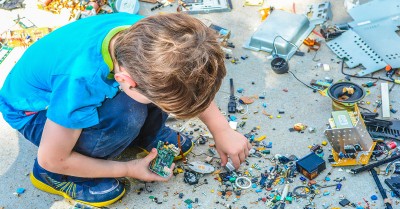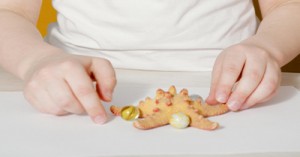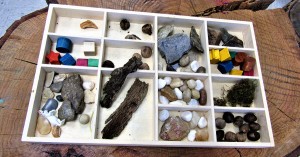When playing with things, children are usually attracted to those that are colourful, easily handled, made up of many components and allow enough room for their curiosity. Loose parts is a term used in early childhood learning to include such object and materials that children can move, control and change in numerous ways.
The greatest benefit in using loose parts to inspire play lies in its sheer variability. It offer learners infinite possibilities for play as they line up, scatter, carry, knock about, take apart, put together and redesign these parts. As an educator, you can support your learners by providing easy access to variety of loose parts ranging from boxes and blocks to beads, sticks, ribbons, stones and rings among others.
Nurtures Creativity
Since loose parts come with no specific set of directions, they work wonders to arouse the creativity and imagination of children. Whether alone or combined with other materials, such objects can take up whatever role the player assigns to them. So in the space of a single hour, a stick can become a magic wand, a fishing rod, a spoon for stirring a stew or a bridge across a puddle for caterpillars. This trait of loose parts enables children to create their own stories, experiment with roles, don multiple perspectives and push boundaries of the possible.
Appeals To The Senses
The more children use all their senses early in their lives, the more their brains build neural pathways and synapses, leading to better cognitive skills in later life. A great way to engage all the senses in your young learners is through play with loose parts. Keep a variety of materials and textures like wood, yarn, clay, string, fabric, cardboard, sponge within easy reach for the them to pick and play with.
Makes Them Move
Play is essentially active and self-driven. In keeping with these traits, playing with loose parts too makes for movement and action. Help the process further by supplying your learners with scarves, hoops, and ribbons that they can twirl, wave, flutter even as their limbs and gross motor skills get a thorough workout.
Easily Accessible
The other great advantage of using loose parts to plan playtime activities is they are affordable. Look for ways you or the children’s parents can recycle material lying about in the house as loose parts for play. These could be anything from small boxes and jar lids to buttons and colourful cups
Aid Learning
All educators know that among the easiest ways to introduce children to numeracy is with sorting, classifying, combining and separating activities which are especially enjoyable with small loose parts, like blocks and bottle caps. Again as your learners use loose parts like scarves and bands as props to tell stories, such play also fosters language development and vocabulary building even as working in groups strengthens social skills and problem solving.
"When children interact with loose parts, they enter a world of "what if" that promotes the type of thinking that leads to problem solving and theoretical reasoning. Loose parts enhance children's ability to think imaginatively and see solutions and they bring sense of adventure and excitement to children's play" - Daly and Beloglovsky 2015
Reference:
Loose Parts - What Does This Means, Penn State University







 As an Educator in Australia, your pay rate falls under the Children’s Services Award 2010. This award states the minimum amount that an employer can
As an Educator in Australia, your pay rate falls under the Children’s Services Award 2010. This award states the minimum amount that an employer can When working as a qualified Early Childhood Teacher (with a university degree) within a service, your rate of pay will come from the Educational Services
When working as a qualified Early Childhood Teacher (with a university degree) within a service, your rate of pay will come from the Educational Services When working as a Diploma Qualified Educator your pay rate is from the Children's Services Award 2010. This Award states your minimum rate of pay
When working as a Diploma Qualified Educator your pay rate is from the Children's Services Award 2010. This Award states your minimum rate of pay When working as a Cert 3 Qualified Educator, your pay rate is from the Children's Services Award 2010. This Award states your minimum rate of
When working as a Cert 3 Qualified Educator, your pay rate is from the Children's Services Award 2010. This Award states your minimum rate of Educational Leaders play a crucial role in their early childhood service by ensuring that the educational program aligns with best practices and supports the holistic
Educational Leaders play a crucial role in their early childhood service by ensuring that the educational program aligns with best practices and supports the holistic In early childhood education and care, ratios are more than a technicality—they are a frontline safeguard. Every child deserves responsive supervision, emotional connection, and developmental
In early childhood education and care, ratios are more than a technicality—they are a frontline safeguard. Every child deserves responsive supervision, emotional connection, and developmental With the new national child safety reforms kicking in on 1 September 2025, early childhood services like yours have a real opportunity to lead the
With the new national child safety reforms kicking in on 1 September 2025, early childhood services like yours have a real opportunity to lead the Here’s a comprehensive Mobile Phone and Smart Watch Policy tailored for early childhood education and care (ECEC) services in Australia, aligned with the latest 2025
Here’s a comprehensive Mobile Phone and Smart Watch Policy tailored for early childhood education and care (ECEC) services in Australia, aligned with the latest 2025 The Sea of Fish Challenge is a national initiative that invites children, educators, families, and communities to create and display fish artworks as a symbol
The Sea of Fish Challenge is a national initiative that invites children, educators, families, and communities to create and display fish artworks as a symbol Across the early childhood education and care sector, educators are sounding the alarm: current staffing ratios are insufficient to deliver safe, meaningful, and developmentally appropriate
Across the early childhood education and care sector, educators are sounding the alarm: current staffing ratios are insufficient to deliver safe, meaningful, and developmentally appropriate


